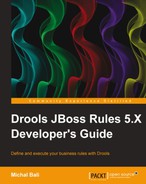Book Description
For Java developers this is the ultimate guide to coding business rules using the Drools platform. It’s a chance to get a deep grounding in it all through a logical step by step approach using many real-life examples.
- Learn the power of Drools as a platform for writing your business rules
- Integrate Drools into your Java business application using the Spring framework
- Through real-world examples and solutions, you will be taken from novice to expert
In Detail
Writing business rules has always been a challenging task. Business rules tend to change often leading to a maintenance nightmare. This book shows you various ways to code your business rules using Drools, the open source Business Rules Management System.
Drools JBoss Rules 5.5 Developer’s Guide shows various features of the Drools platform by walking the reader through several real-world examples. Each chapter elaborates on different aspects of the Drools platform. The reader will also learn about the inner workings of Drools and its implementation of the Rete algorithm.
The book starts with explaining rule basics, then builds on this information by going through various areas like human readable rules, rules for validation, and stateful rules, using examples from the banking domain. A loan approval process example shows the use of the jBPM module. Parts of a banking fraud detection system are implemented with the Drools Fusion module which is the complex event processing part of Drools. Finally, more technical details are shown detailing the inner workings of Drools, the implementation of the ReteOO algorithm, indexing, node sharing, and partitioning.
Table of Contents
- Drools JBoss Rules 5.X Developer's Guide
- Table of Contents
- Drools JBoss Rules 5.X Developer's Guide
- Credits
- About the Author
- About the Reviewers
- www.PacktPub.com
- Preface
- 1. Programming Declaratively
- 2. Writing Basic Rules
- Rule basics
- Rule syntax
- Summary
- 3. Validating
- 4. Transforming Data
- 5. Creating Human-readable Rules
- 6. Working with Stateful Session
- 7. Complex Event Processing
- 8. Defining Processes with jBPM
- 9. Building a Sample Application
- 10. Testing
- 11. Integrating
- 12. Learning about Performance
- A. Setting Up the Development Environment
- B. Creating Custom Operators
- C. Dependencies of Sample Application
- Index
